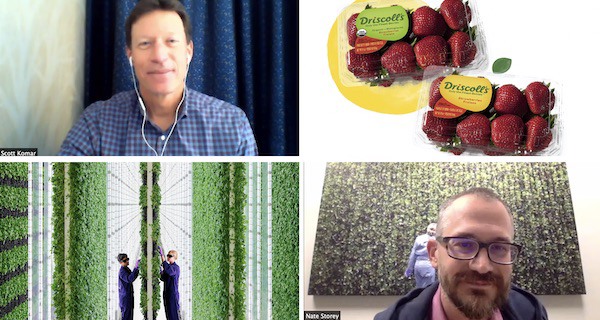In October, Driscoll’s and Plenty Unlimited Inc. announced a partnership to grow Driscoll’s proprietary strawberries year-round in Plenty’s vertical indoor farms. Last week, Scott Komar, Driscoll’s Senior Vice President of Global R&D & Plenty’s Co-Founder and Chief Science Officer, Nate Storey joined on a webinar hosted by SVG Ventures | THRIVE to talk about the what this partnership will look like.

Vertical farms: growing more produce in less space
Plenty currently has two vertical farms, one in south San Francisco and one in Compton. “We are trying to change the story of eating healthy. We want to change the eating experience in a way where something like kale can be both delicious and delightful to both adults and kids. We want to create a world where people can eat fresh fruits and vegetables because its available, affordable, and enjoyable. We aren’t looking to replace traditional field farming; we need the field to produce and to continue to do so. But realistically, we need to double or triple the size of produce production if we want to feed the world, and that’s not something that can be achieved with the land we have today,” Storey shares.
That’s where vertical farming comes in: by leveraging vertical planes, these farms can grow a lot of plants in a small space to produce massive amounts of produce in the cities that they serve. “Because we grow so close to the end consumers, we can focus on quality, flavor and other aspects that usually don’t stand up well in long supply chains.”
Controlled growing environment close to end consumers
Due to Plenty’s growing systems, any varieties that might be specifically sensitive to environmental changes or long supply chains can be grown in a controlled environment close to the end consumer. For Driscoll’s, this seemed like the perfect match. Komar explains: “Strawberries have a complex genome and out of all of our berries they are the most sensitive to the environment. For each of the regions that we grow in, we have a unique breeding program that is adjusted specifically for the environment of that region. That’s why we were intrigued by Plenty’s farms, because they offer a growing system where the weather and climate are perfectly controlled. Every year we trial so many varieties in our breeding program and many amazing varieties are discarded because it isn’t likely that they’ll be able to travel through the normal supply chain. Our belief and premise is that the Plenty growing system will allow us to market some of these varieties, that they might be optimal for indoor growing.” The company currently has 10 varieties that they will be trialing with Plenty. “Our first phase of the partnership now is testing these varieties,” Komar says.
By producing the products closer to the end consumers, the companies are also looking to expand the overall reach of fresh produce throughout the world. “There are many major cities where it’s challenging to distribute any kind of produce – especially perishable produce, and especially if it’s located in a climate that’s not conducive to it. So, at Driscoll’s we were looking at how we could extend our global reach and then we got to know Plenty, who grow in a perfectly controlled climate and have a very short supply chain. Now that we have established the partnership, we want to explore how to unlock our genetics and breeding in the Plenty environment, working closely with their technology. We want to take this to major cities and extend our global reach,” says Komar.
The flavor focus
By growing produce in a highly controlled, high-tech environment, the growers are able to create the perfect growing environment for highly sensitive varieties. “We have two main goals for our produce,” Storey says. “First of all, we want to find the best version of a product. What would that strawberry taste like if it was grown without any of the environmental stressors that could impact the quality? Then deliver that, the best eating experience possible, to the consumer. Being able to eliminate stress to the plant every day helps yield and quality, and we can become designers of flavor. You can look at the plant and say exactly how much sugar you want in your berries, what texture you’re looking for, and then make that happen,” he shares.
The second goal Plenty wants to achieve is to bring the consumer entirely new flavors. “Most people are accustomed to specific flavors, which are driven by the traditional production and supply chain models, but there are so many other flavors out there waiting for people to experience them. So, we hope to bring people strawberries that taste like the best version they’ve ever had and allow them to taste things that they’ve never tasted before in strawberries,” says Storey.
Driscoll’s already works to bring new varieties to consumers throughout the year and hope to expand this through the partnership. “We have our Rosé Berries, which are a limited, seasonal item and a consumer favorite, for example. We expect to find more of these innovative varieties within this partnership and unlock more new flavors that we didn’t even know about before,” Komar concludes.
 For more information:
For more information:
Fran Dillard
Driscoll’s
Email: press@driscolls.com
www.driscolls.com
 Jane Gideon
Jane Gideon
Plenty
Email: press@plenty.ag
www.plenty.ag
